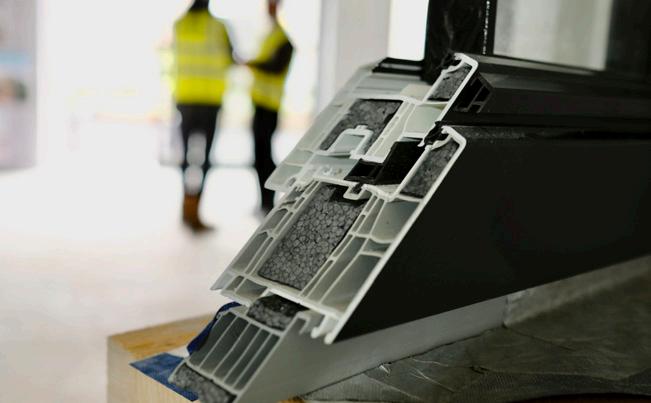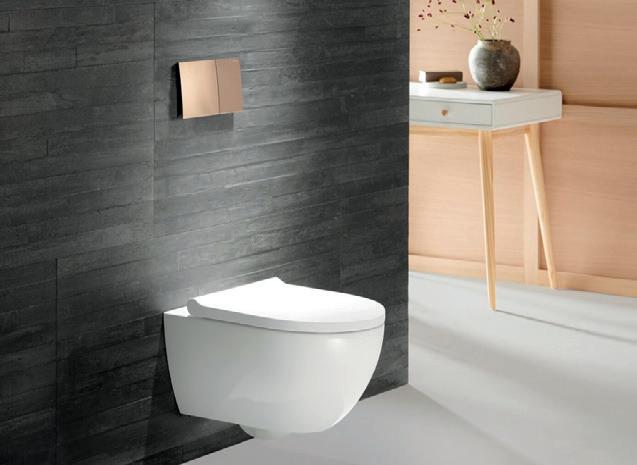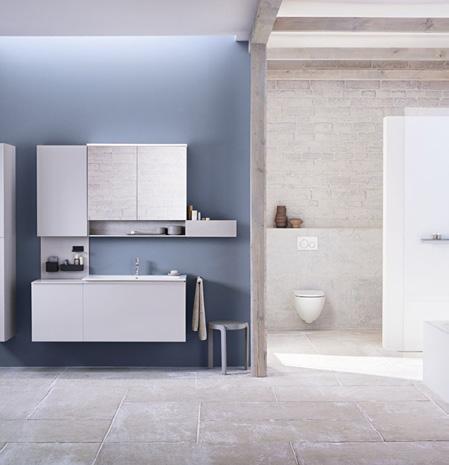
June 2024 Issue 142 Public Sector Build Journal Leisure Housing Education Healthcare psbjmagazine.com
BRIDGING GAPS AND BUILDING FUTURES
From higher education coldspot to hotspot: ARU Peterborough transforms city’s prospects
Streamlining success: Efficient NHS estates through PAM framework
both
Navigating procurement with
adaptability and compliance
Carbon-neutral timber tech reshapes Scotland’s manufacturing scene


Specialising in modular construction for 90 years CONTACT US TODAY 0800 18 18 22 | www.wernick.co.uk buildings@wernick.co.uk Find out more Scan the QR code 50+YEARS DESIGN LIFE SUSTAINABLE CONSTRUCTION FULL PROJECT MANAGEMENT MINIMUM ON-SITE TIME FLEXIBLE RELOCATABLE WERNICK MODULAR BUILDINGS DELIVER...

Editor
Rebecca Kemp rebecca@redhutmedia.com
Print & Digital Advertising
Sam Ball sam@redhutmedia.com
Jim Moore jim@redhutmedia.com
Print Design Manager
Jack Witcomb jack@redhutmedia.com
Digital Design Manager
Matt Morse matt@redhutmedia.com
Accounts Rachel Pike accounts@redhutmedia.com
Publisher Sam Ball sam@redhutmedia.com
Published by Red Hut Media Ltd. 2, The Old Stable Block, Crescent Road, Faversham, Kent, ME13 7GU
psbjmagazine.com 01795 515288 redhutmedia.com

Welcome to the June issue of PSBJ...
In the wake of May’s cryptosporidiosis outbreak in the Southwest, which left around 2500 properties in Devon advised to boil their water due to traces of the waterborne illness, the importance of a clean water supply has been underscored. While the incident is parasitic in nature, it draws attention to broader dangers posed by contamination, including those present in both homes and public buildings.
In this issue, the Copper Sustainability Partnership (CuSP), in collaboration with Safe Piping Matters, unveils the findings of its report, ‘Plastic Pipes, Microplastics & Impacts on Human Health’. The information sheds light on the detrimental effects of microand nanoplastics on our health, particularly emphasising the heightened risks within hospitals and households. For a deeper dive into this topic, turn to page 18.
Water provision concerns persist in the NHS, amidst significant infrastructural obstacles and a staggering maintenance backlog of £11.6bn1. Coupled with over 100 care disruptions reported weekly (revealed earlier this year), these difficulties place immense pressure on estate and facilities management (FM), often necessitating reactive responses to emerging problems. In this edition, Penny Brinsley, Account Director at Service Works Global, explores the effectiveness of the Premises Assurance Model (PAM) framework. Here, she discusses how PAM can facilitate compliance assessment with legislation and guidance, inform investment prioritisation and establish resilient systems. For insights on leveraging PAM effectively and common challenges encountered, refer to page 30.
Elsewhere, we feature ARU Peterborough, one of the UK’s newest universities designed by MCW architects; Matt Rudman from SLR Consulting examines the £2.5bn mass transit system linking Leeds and Bradford; and we take a closer look at The Harris, a Grade I-Listed landmark in Lancashire renowned for its historic exhibits and free library.

Contributions
I hope you enjoy this issue. Don’t forget, you can also access the magazine’s features, product news and supplier information on PSBJ’s user-friendly and engaging website. Fully responsive, the website allows you to read all the latest stories on the go either on your smartphone or tablet. Simply visit www.psbjmagazine.com.
FOOTNOTE:
1https://www.theguardian.com/society/2024/jan/26/crumbling-english-hospitals-cause-over-100-patientcare-disruptions-week?CMP=Share_AndroidApp_Other
03
Rebecca Kemp •
•
Find us on Social Media:
ARU Peterborough is one of the UK’s newest universities designed by MCW architects. See page 26.
Editor
rebecca@redhutmedia.com
are invited and when not accepted will be returned only if accompanied by a fully stamped and return addressed envelope. No responsibility will be taken for drawings, photographs or literary contributions during transmission or in the editor's hands. In the absence of an agreement the copyright of all contributions, literary, photographics or artistic belongs to Red Hut Media Ltd. The Publisher accepts no responsibility in respect of advertisements appearing in the magazine and the opinions expressed in editorial material or otherwise do not necessarily represent the view of the publisher. The Publisher does not accept any liability of any loss arising from the late appearance or non publication of any advertisement.
PSBJ is a proud supporter of the Chartered Institute of Architectural Technologists. WELCOME NOTE @psbjmagazine
Rebecca
A round up of the latest industry news, including charity events, awarded contracts, completed projects and much more.
08 Upfront
Matt Rudman, Regional Director for Transport and Mobility Planning at SLR Consulting, unpacks the potential of the £2.5bn Leeds and Bradford tram proposals and its implications for wider city development.
12 Housing
Discover how REHAU’s GENEO Passivhaus windows met rigorous standards on a Passivhaus-certified development for Midlothian Council, ensuring thermal efficiency and low-maintenance durability.
14 Rooflights
From the challenges of single glazing to bespoke solutions like pyramid rooflights, Tracey Jackson, Business Development Manager at Howells Patent Glazing, explores how modern upgrades can harmonise with historic structures.
16 Floors, Walls & Ceilings
Thanks to the collaborative efforts of B&K Structures, HLM, Waterman Group and others, the National Manufacturing Institute Scotland’s (NMIS) new state-of-the-art facility is set to revolutionise the future of manufacturing in Scotland.




18 Infection Control
The alarming impact of plastic pipes in homes and hospitals is revealed in a new report by CuSP. Microplastics and nanoplastics from these pipes pose significant health risks.
20 Sustainability
Preserving public sector infrastructure with powder coating: Richard Besant, Director at Powdertech, explores the sustainable and budget-friendly benefits of this durable solution.



22 Glass & Glazing
ESG’s Commercial Manager, Susan Sinden, explains how switchable privacy glass is revolutionising hygiene and patient care in hospitals.
24 Legal & Business
Flexibility is the cornerstone of futureproof frameworks in the public sector. Here, Pagabo highlights the importance of adaptability amidst tightening regulations and shifting dynamics.











Latest Schöck BBA Certi cation raises the bar.










No need to compromise on performance, quality or service.
Schöck products meet full compliance with relevant UK building regulations, are approved by the BBA, NHBC accepted and classi ed as re resistance class REI 120.

www.schoeck.com



04 CONTENTS 12
06 News
Thermal break technology you can trust.
240175_Anz_IK_PSBJ Magazine_185x131_GB_rz.indd 1 22.03.24 12:20

26 Education
ARU Peterborough, the newest addition to the UK’s educational landscape, is breaking down barriers and opening doors to higher education for all.
28 Talking Point
From Section 114 notices to the proposed Infrastructure Levy, uncover the challenges and potential solutions surrounding local authority financing with insights from Mark Edgerley, Associate Director at Boyer.





30 Healthcare
Penny Brinsley, Account Director at Service Works Global, explains how NHS trusts can leverage the Premises Assurance Model (PAM) to ensure safe, effective and sustainable healthcare environments.
32 Technical Focus
Tim Tanner, Product Technical Manager –Ventilation Technology at TROX UK, reveals the unique air conditioning challenges associated with exposed ceilings.

34 Leisure
Led by Conlon Construction and a dedicated team of partners, the ambitious restoration of The Harris is breathing new life into the iconic Grade I-Listed building, preparing it for another century of cultural enrichment.
36 Product Guide
A dedicated focus of industry news, products and case studies to help specifiers and local authorities make informed decisions.





05 CONTENTS 34 08
Manufactured, Tested, Specified, Certified For more details, call our specialised team on: 01233 639039 sales@sunraytimberdoordivision.co.uk | www.sunraytimberdoordivision.co.uk Sunray is the specifiers choice for Timber Fire Doors and passive Fire Protection. Our comprehensive Timber Door Range provides Fire Integrity from FD30 to FD120 and Security Rating of SR1 & SR2 with Fire Secure. All Doors are bespoke enabling specialist hardware, vision panels, overpanels and of course colours and finishes. We operate in numerous sectors and provide performance specifications to meet project requirement.
INDUSTRY UPDATES
Each month, PSBJ rounds up the latest public sector construction updates, from new contracts to industry awards.

£26m investment paves the way for health and wellbeing hub
South Holland District Council has bolstered its successful £20m UK Government Levelling Up Fund bid with a £6m investment to see the Castle Sports Complex in Spalding transformed into a health and wellbeing hub to drive positive health outcomes for residents across the district. Alliance Leisure has been appointed to deliver the works through the UK Leisure Framework, owned by Denbighshire Leisure Limited (DLL). Works are expected to begin in the autumn and will see the Castle Sports Complex completely remodelled and extended to include an integral swimming provision. A six-lane, 25m pool will be supported by a second, 20m teaching pool for individuals, groups, clubs and local schools, giving young people access to the facilities they need to develop essential swim skills. Outside, a splash pad will also be added to accommodate families and young children. These facilities will replace the current provision offered by Spalding Swimming Pool. The new wellbeing hub will also host a sports hall, gym, family activity zone, a fully-equipped fitness suite, indoor cycling and fitness studios, a dedicated wellness suite offering power-assisted exercise and a health and wellbeing space for appointments with health practitioners.
Drees & Sommer UK secures place on NHS SBS framework
Drees & Sommer UK has secured a major NHS framework agreement after being named a supplier on the NHS Shared Business Services (NHS SBS) for consultancy and advisory services for health. Through the framework agreement, Drees & Sommer UK will support the NHS and other public sector clients with various services after securing four of the lots applied for. This includes Lot 1 – Business, Leadership, Management, Governance, Structure & Strategy, Lot 5 – IT Business Consultancy, Lot 9 – Social Value, Sustainability, and Carbon Neutrality, and Lot 10 – Property. The new agreement is a testament to Drees & Sommer UK’s substantial experience within the health sector, having operated multiple major consultancy assignments across the UK, including Manchester University NHS Foundation Trust Estates, West Hertfordshire Hospitals NHS Trust, North London Mental Health Partnership, Birmingham & Solihull Mental Health NHS Foundation Trust, Lancashire Teaching NHS Trust, University Hospitals of Morecambe Bay NHS Foundation Trust, Community Health Partnerships, NHS Property Services and more. After completing the merger of Drees & Sommer’s established UK business and leading UK consultant AA Projects, the team has strengthened its capabilities in several areas, including IT business consultancy, which played a pivotal role in its appointment to the NHS SBS framework.

Beard breaks ground on new purpose-built Surrey hospice
Beard Construction has broken ground on a new 3700m2 hospice in Farnham, Surrey. The project, worth £11.9m to the award-winning contractor, will see Beard build the brand-new Phyllis Tuckwell Hospice, which provides a full range of services, including critical, end-of-life care. The new purpose-built hospice will include a low-level, single-storey building, which consists of 18 bedrooms with ensuite wetrooms. Each room will have bi-fold doors that will open out into the courtyard or surrounding gardens. This will be supported by specialist suites for education, wellbeing and exercise. High-end materials and finishes, combined with Beard’s reputation for quality and excellence, will ensure greater levels of comfort, dignity and privacy for patients and their families. The inpatient unit will be attached to a two-storey concrete-frame building. The ground floor will include the main reception and lobby, as well as kitchens, cafeteria and lounges. It will also house the main plant room, utility room and clinical rooms. The first floor will provide office facilities for Phyllis Tuckwell staff, who have been relocated to various temporary sites. The new hospice is due to be completed towards the end of 2025 and will be a much larger and more modern facility.
Good progress made at Whitecraig Primary School
Good progress is being made on a new primary school for Whitecraig as work gathers pace on site. Construction began in February 2024 on a new primary school for the village to accommodate a growing school roll. Mainline drainage infrastructure works have been completed while construction of a new site access road and school car park are ongoing. The new school is being built on land adjacent to the current building. Once the new school is completed and occupied, the existing school building will be safely demolished, and the footprint will be landscaped to provide a playground area. The project has received money from phase one of the Scottish Government’s Learning Estate Investment Programme, administered by Scottish Futures Trust. Morrison Construction was awarded the £18.5m contract to deliver the project. Cabinet member for Education and Children’s and Family Services Councillor Fiona Dugdale visited the site to meet with the project and contractor teams, Whitecraig Primary School Head Teacher, Viv Short, and pupils. She said: “We have committed over £93m in our five-year capital programme for our education estate, including the development of three new primary schools, as well as extensions and upgrades to a number of other buildings. This is to help us achieve our aim to provide high-quality, inspiring and nurturing environments for learning that benefit wider communities.
06
NEWS

Construction begins on £20m expansion of Ysgol Y Deri, Vale of Glamorgan
ISG has announced the commencement of work on the £20m Ysgol Y Deri expansion project for Vale of Glamorgan Council. The provision of an additional site is part of the Welsh Government and Vale of Glamorgan Council’s Sustainable Communities for Learning Programme to increase the number of special education places available. Originally constructed to accommodate 205 pupils with complex physical, health and educational needs, the original school is currently oversubscribed, in a trend that is likely to continue as pupils stay on for longer periods. The proposal to expand Ysgol Y Deri with additional places on a split-site provision was selected as the preferred option to deliver additional pupil places, with the project now underway. The second location is in Cosmeston, within close proximity to the original build. Angela Sheppard, Project Lead at HLM Architects, comments: “Ysgol Y Deri’s expansion is another key project for the Vale of Glamorgan, providing essential spaces for pupils with additional learning needs. We’re pleased to be part of delivering this vital infrastructure to better accommodate the diverse needs of pupils in the area.” Kevin McElroy, Operations Director at ISG, adds: “Bringing new learning spaces to Ysgol Y Deri resonates deeply with us. With external spaces designed to function as an extension to the school buildings, the project pursues the balance for pupils both in study and social wellbeing and provides holistic spaces for their additional learning needs.”
Works progressing on new £3.6m medical centre
in Leicestershire
Midlands contractor, G F Tomlinson, is progressing works on the new Barwell Medical Centre in Leicestershire. The new twostorey doctor’s surgery, located off High Street, Barwell, will replace the existing centre on Jersey Way, which is at capacity and unable to meet the growing demand for its services from the local community. Due for completion in June 2024, the new medical centre will provide modern healthcare facilities to many more local people, with demand expected to grow from its current 6400 to 11,000 users over the next five to 10 years. The additional space at the new centre will allow it to provide a greater range of much-needed health services, including physiotherapy and mental health support. The new L-shaped building will consist of 12 consulting rooms, a space for minor surgical procedures with recovery facilities, a health promotion area, as well as 52 car-parking spaces and six cycle racks. The centre will be constructed to BREEAM ‘Excellent’ standards, ensuring the long-term sustainability of the new medical centre. Demolition works at the unused brownfield site have already taken place, which saw the removal of a former vehicle workshop and warehouse.

Construction completes on
£12m new home for Sandhurst band
A £12m facility supporting army musicians at the Royal Military Academy Sandhurst (RMAS) has been completed, delivering a flagship environment for military performances. The new purposebuilt space, which held its topping-out ceremony last September, can now house all 54 musicians serving under British Army Band Sandhurst in an acoustically-optimised space for rehearsals and performances. The new and refurbished buildings feature an instrument store, music library and rehearsal rooms, as well as offices, storage, changing rooms and a crew room that will support performances, such as passing-out parades and Sovereign’s parades. The project was funded by the Defence Infrastructure Organisation (DIO) under the Defence Estate Optimisation (DEO) Army Programme, which is investing £3.35bn over 10 years to improve living, working and training accommodations for those who serve in the Army. Multi-disciplinary consultancy firm Pick Everard was behind the scheme, operating through Perfect Circle to deliver project management and NEC supervisor services alongside contractor Willmott Dixon and HLM Architects. Accelerated under the SCAPE Consultancy framework, the completed work achieved Defence Related Environmental Assessment Methodology (DREAM) ‘Very Good’ and ‘Excellent’ ratings, contributing sustainably to the built environment.
Wates Group set for Channel View regeneration scheme in Cardiff
NHBC, the UK’s leading independent provider of warranty and insurance for new-build homes, has brought together some of the leaders of local authority development and regeneration to share their thoughts on this important sector. Available in print and to download, ‘Built. On insights – a collection of industry insights from leaders in local authority development’, has been produced to highlight the important work undertaken by local authorities. It raises questions about the viability of local authority housing in its current form and celebrates the dedicated professionals delivering quality housing in challenging circumstances. Contributors share their career journeys, views on the market and local authority priorities. They give a personal perspective on their work with their unique insight. Examining the current state of local authority residential development and the difficulties faced by many councils, this book covers everything from regeneration and retrofitting to partnership working and methods of modern construction (MMC). It also gives insight into the motivations of its contributors; from personal backgrounds and early careers, right through to their hopes for the future, this publication portrays the people, as well as the developments they lead.
07
NEWS

TICKET TO RIDE – HOW THE LEEDS AND BRADFORD TRAM PROPOSALS COULD BE A BLUEPRINT FOR SUCCESS
The recent announcement of a £2.5bn mass transit system between Leeds and Bradford has once again highlighted the Government’s intention to develop tram systems in some of the UK’s key cities.
att Rudman, Regional Director for Transport and Mobility Planning at SLR Consulting, takes a closer look at the scheme, which has been dubbed as the biggest infrastructure project West Yorkshire has seen since the development of the motorways six decades ago, and discusses what it tells us about wider opportunities.
As the clock counts down towards a general election at some point in the next nine months, it feels inevitable that the current Government’s legacy around public transport will be tied to HS2. Last October’s announcement of ‘Network North’ as a replacement for the scrapped northern leg of the rail project – which would have served Leeds before cutting through the Pennines to Manchester – received a lukewarm reaction from infrastructure industry experts at the time, but the recent plans for the £2.5bn tram link for Leeds and Bradford have been well received in West Yorkshire.
Heavy rail transport infrastructure in Leeds and Bradford is generally pretty good – Leeds railway station, in particular, is a strong hub location for links to the rest of the north and beyond – but when the tram proposals were being consulted upon around a year ago, it was clear that the capacity constraints of the road system were acting as a major block to wider regeneration efforts across both cities.
With growing populations, the need for new housing to support those moving into the area means that the local Government – led by Combined Authority Mayor, Tracy Brabin – has had to think laterally about other modern methods of transport and how they can be considered in the wider mass transit strategy for the region.
The result is the recently-announced design for a two-line tram system linking the cities and across Leeds, which represents a significant step forward for
the area. The area has had a number of false starts, including a trolleybus scheme that was scrapped eight years ago.
Connecting cities, communities and key facilities
On the face of it, the benefits of a modern, clean and environmentallyfriendly method of transport that is widely accessible are patently obvious, but if you scratch beneath the surface, it’s an even better proposal than it first appears.
It’s clear that the scheme developers have learnt from past mistakes in that the proposed routes are ideally placed to benefit the most areas possible. The first phase – provisionally labelled the Leeds Line – is currently slated to link St James’ Hospital through to Leeds city centre, then on to Elland Road stadium before terminating at the White Rose Shopping Centre.
UPFRONT 08 M

As well as linking the city to both hospitals and two locations – the stadium and the shopping centre – that have significant footfall, this line also better connects growing suburbs such as Morley with the city centre, guaranteeing good patronage and revenue for the system and enabling growth at these nodes. The Bradford Line would then run from Leeds city centre to Bradford city centre – also linking Bradford Forster Square station with the Interchange and the site of a new Bradford rail station. This will have a significant positive impact on the proposed regeneration of Bradford’s southern gateway, which was launched in November last year with the aim of providing new health facilities, shopping areas, employment sites and thousands of new homes.
As someone who has worked on projects in the West Yorkshire area for several years, this kind of approach has been something that has been needed for a while and it has taken a devolved Government to design and potentially deliver it. If you zoom out and look at the bigger picture, Leeds and Bradford combined is a metropolis of just over 1.2 million people separated by just eight miles as the crow flies.
From an international standpoint, for an area that has a larger population than the likes of Lisbon and Amsterdam not to have a light rail system simply doesn’t make sense and prevents the region from being included with other cities that think internationally.


09 UPFRONT

The long-term view
If you look closer to home, the success of tram systems in the likes of Manchester and Nottingham – which has doubled in size in the last decade and now serves 14 million journeys per year – should act as a blueprint for how to connect the communities of each city and realise the benefits from this infrastructure.
Using Nottingham as an example, the suburb of Beeston has seen a £3m regeneration project that has brought new homes and amenities almost solely off the back of it being on the tram network. This not only means residents can get into the city centre easily – accessing higherpaid jobs in the process – but it has also created the idea of Beeston itself being a destination, drawing people from the city and improving its cultural vitality.
In political terms, mass transit systems should be considered as a high-reward, low-carbon policy option for whoever wins the next general election. Not only do they have the potential to unlock future developments of both housing and commercial opportunities, but they also have the ability to grow city regions through densification – many of which will be introducing metropolitan mayors for the first time in the May local elections.
Ironically, the low-carbon agenda took a severe hit in the same Rishi Sunak conference speech that saw the announcement of the Leeds-Bradford plans, with several key climate targets being scrapped.
However, mass transit systems have the ability to grow cities and regions in a way that is sustainable in all senses of the word.

10
UPFRONT www.slrconsulting.com

MIDLOTHIAN COUNCIL FRAMES PASSIVHAUS HOMES OF THE FUTURE WITH REHAU PVCU
With housing providers under pressure to deliver affordable housing that meets the UK’s net-zero targets, new developments must be both environmentally conscious and consumer friendly. Midlothian Council built Passivhaus-certified social homes in two of its newest developments. With windows playing a fundamental role in achieving the levels of airtightness, insulation and overall efficiency required in a Passivhaus building, close attention was paid to the material choice, style and U-value of the frames.
Passivhaus is a tried-and-tested methodology that provides a range of solutions to deliver net-zero-ready homes. To achieve optimal comfort levels for occupants, the standard ensures homes use very little energy for heating and cooling, relying on high levels of insulation and airtightness, and a MVHR unit.
Tackling fuel poverty with sustainability champions
In 2020, Midlothian Council, the local authority for Midlothian, Scotland, committed to building new Passivhaus social housing and set this out in its housing design guide. The main aims of the project were to help the council meet wider net-zero targets while tackling the issue of fuel poverty and improving the provision of comfortable housing.
The first two developments assigned were Buccleuch Street in Dalkeith – one building housing six flats, and Burnbrae Road in Bonnyrigg – two buildings encompassing a mixture of retail and residential properties.
Knowing that achieving such rigorous standards would be no easy feat, the council appointed Smith Scott Mullan Associates, an Edinburgh-based architectural practice, and industry leader of sustainable design practices. Their team of dedicated professionals now includes six certified Passivhaus designers, two PAS 2035 coordinators, and two accredited conservation architects. Leading the project was Claire Cockburn, Senior Architect and certified Passivhaus Designer, and Jarek Gasiorek, Architect and certified Passive House Designer. Specialist Passivhaus Consultant, Graham
Drummond, was also appointed as part of the team to advise on specific areas such as window material choice.
The Burnbrae Road challenge
Burnbrae Road brought with it its own set of technical difficulties. The two-block project in Bonnyrigg, delivered by contractor Fleming Buildings, comprised a mix of residential and a retail unit, which required a customised Passivhaus certification process. While all 20 homes were to be designed to achieve Passivhaus certification, the retail unit was only required to have a Passivhaus-compliant envelope with double-glazed windows and steel security doors. Due to this unique challenge, the Passivhaus certifier, WARM, and Passivhaus Institute had to agree on a customised certification to make the project a reality. The average U-value targeted at the design stage was 0.83W/(m2K) across a total of 48 windows.
The Buccleuch Street challenge
The project at Buccleuch Street followed a similar specification to Burnbrae, and was delivered by contractor Morris and Spottiswood. This was to develop a new block of six flats and the refurbishment of a nearby existing building. However, the site was constrained and involved competing demands. The need for fire safety, structural stability and space to house the mechanical ventilation with a heat recovery system (MVHR) created conflicting needs that required adaptable solutions. The average U-value targeted at the design stage was 0.87W/(m2K), across a total of 32 windows.
12 HOUSING
©GRM Windows

A not-so-common solution
Despite the plethora of nuances across each project’s design, two things were non-negotiable when it came to the windows – the thermal efficiency and the maintenance conditions. A variety of options were considered in early technical workshops between Graham Drummond, Smith Scott Mullan Associates and contractors. PVCu was agreed upon as the material of choice due to its low-maintenance properties and more cost-effective price point against alternatives like timber. Graham then went on to recommend REHAU’s GENEO Passivhaus windows based on his previous experience with the product and its niche ability to meet the rigorous technical specification – unlike many other PVCu alternatives in the market.
Specialist fabricator, and one of a handful in the UK who can manufacture windows to this specification, GRM Windows, was then appointed, after a tendering process, to supply the final product across both sites: The REHAU GENEO Tilt and Turn: 86mm profile depth utilising RAUFIPRO X – a fibre composite extruded profile, with six chamber systems and triple gasket sealing. All 80 windows were supplied with anthracite grey exterior frames to match the modern design of the homes, and all Secure by Design certified for additional resident safety.
Midlothian Council was keen to involve REHAU and GRM’s expertise in all stages of the development process across both sites, from design to fit. Project Manager, Neil Davidson, comments: “The REHAU and GRM teams have been an integral part of the design and build process across both multi-faceted projects. The windows met Passivhaus standards, and the REHAU team’s technical expertise informed many decisions throughout the build.”
Richard Gambling, Managing Director at GRM, added: “The main challenge on this project was balancing all aspects of the design. By working in close collaboration with our glass supplier, we were able to test the GENEO to PAS 24 at a specific size for Buccleuch Street. We also achieved around 44 dBA reduction on one elevation at the same time as meeting thermal and solar gain requirements of the Passivhaus design team. This wouldn’t have been possible without the support from REHAU – all queries from the designers and contractors were solved accurately and quickly.”

Framing social homes of the future
Thanks to airtight seals and membrane features, not only were sustainability targets met, but noise attenuation parameters were also maintained. Due to a local social club next door to the Buccleuch Street site, these windows were designed to an even higher specification to provide residents with peace and quiet inside their homes.
Alongside the use of other technologies, including solar photovoltaics, heat storage and electric heating, the projects were some of the first Passivhaus triumphs of its kind in Scotland and have set a very high standard for the future of social homes.
Neil adds: “Across both projects, the REHAU team provided technical insight throughout the design process that will be transferable for those working on site in future Passivhaus projects.”
On the success of the Passivhaus project, Samsara McDonald, Commercial Sales Manager at REHAU, says: “It’s a testament to the REHAU team that we were chosen as the supplier for this first-of-its-kind project in Midlothian. Passivhaus requires some of the highest industry standards to be met and REHAU products do just that. We know that our products speak for themselves with unbeatable U-values and the capability to address a range of project needs, but our team’s expertise and knowledge is what really sets us apart.”
13 HOUSING window.rehau.com/uk
©Smith Scott Mullen
©GRM Windows

IMPROVING THE ENERGY EFFICIENCY OF OLD BUILDINGS
A building’s condition has a significant impact on energy bills, carbon emissions and occupier comfort. Damp and ill-fitting windows and doors, for example, can really affect thermal performance, says Tracey Jackson, Business Development Manager for Howells Patent Glazing.
hile regular maintenance and repairs can help optimise building performance and stave off invasive and expensive repair and conservation work, there are some building characteristics that present obvious potential for greater improvement.
Most sloping glazing and old roof lanterns and lights are single glazed, for example. Not only is it easier to shatter a single pane
of glass, but single glazing can cause issues with heat loss and condensation, which leads to increased energy costs.
In our 50+ years’ experience, we have encountered several worthwhile solutions – insert sympathetic and appropriate double-glazed units or add secondary glazing. With old buildings, however, it is often not as simple as this, and a bespoke solution is required.

Guidance from Historic England
In a document produced by Historic England, entitled ‘Energy Efficiency and Historic Buildings – how to improve energy efficiency’, replacement glazing is categorised as a ‘red’ action to improve thermal performance – it is a highrisk and high-cost option and careful consideration is needed.
“Single glazing can be replaced with double glazing, but unlike secondary glazing, this will not directly reduce draughts or heat transfer through the frames, it can, however, be combined with draughtproofing”.
Historic England also highlights that “metal frames are cold bridges and are especially likely to attract condensation if reglazed with insulated glass units.”
The key consideration is whether the glazing makes an important contribution to the significance of the historic building. “…Usually very neglected windows can be brought back into condition relatively easily and upgraded with systems such as secondary glazing.”
Bridlington Town Hall
This was the approach we adopted for the refurbishment of the Grade II-Listed Bridlington Town Hall, for which we manufactured and installed three glazing areas, including two pyramid rooflights designed to sit over a pair of original domed lanterns.
The new rooflights provide valuable protection for the glass domes. Each measure 3m2 with a 30° pitch and comprises a square aluminium profile in a Basalt Grey RAL 7012 powder-coated finish. Tested for both weathertightness (BS 6375 Part 1) and Resistance to snow and permanent load (EN 14351), the pyramid rooflights are a far more robust solution than secondary glazing.
They are fitted with 28mm double-glazed units, which aids thermal performance. By sitting these within a modern aluminium structure – using our thermally-broken HG2 and HG3 self-supporting patent glazing system – we can avoid cold bridging and support the overall energy efficiency of the building, too.
The refurbishment of the 1931 Grade II-Listed building had to balance conservation with modernity. The alterations were designed to be sympathetic and complementary, using materials and techniques appropriate to the historic fabric of the building.
The rooflights were supplied as part of a £3m remodelling and upgrading of Bridlington Town Hall for East Riding of Yorkshire Council. This transformation has created an impressive facility in the town with more open-plan areas, which offers a better experience for both staff and the public.
14 ROOFLIGHTS
www.howellsglazing.co.uk
W

SUPERIOR FLUSH PERFORMANCE
Tried, tested and fully compliant; decades of spare parts reliability, outstanding flush performance and easier cleaning. The Geberit WC system has the optimal coordination of concealed cistern, flush plate, flush valve and WC ceramic to offer a wide range of benefits to specifiers and end users. geberit.co.uk/fasterinstallation *Across Duofix Sigma and Omega only.
10XFLUSHINGBETTER PERFORMANCE 40% FASTER INSTALLATION YEARS SPARE PARTS GUARANTEE * 50
GEBERIT WC SYSTEM


ENGINEERED INGENUITY
The new world-class flagship facility of the National Manufacturing Institute Scotland (NMIS) has opened its doors, paving the way for the future of manufacturing in Scotland. The design has pushed the boundaries for the application of engineered timber and required innovative solutions, demanding close collaboration between contractors and consultants. B&K Structures, a UK-leading subcontractor of complex timber and hybrid solutions, was a proud contributor to this pioneering project.
The ground-breaking facility, operated by the University of Strathclyde, boasts BREEAM ‘Outstanding’ status and over 11,500m 2 of operationally carbon-neutral campus. Developed to connect Scottish universities and colleges with industry and the public sector, it aims to undertake pioneering R&D to boost the skills of current and future workforces. Engineered timber is at its core, aiming to promote collaborative working, sustainability and innovation in an environment that is both carbon-neutral and optimised for productivity.
There was an impressive group of specialists leading the project; with HLM as the project architect and Waterman Group designing the foundations, B&K Structures worked with supply chain partner Engenuiti to design the complex glulam, CLT and steel superstructure. B&K Structures called on manufacturer Stora Enso for the CLT aspects and
Rubner to deliver a diagrid-style roof structure, together with the diagonal glulam columns, which define the building’s striking appearance. Visible on the skyline, the 32 x 12m ‘window to the world’ provides a view into the facility, framed by the dramatic glulam structure that springs above the office and collaborative spaces.
Highly recognisable externally and internally, NMIS’ unique structural identity offers an 18 x 80m column-free space, maximising flexibility and the potential for reconfiguration. The prefabricated diagrid structure and panelised CLT roof were assembled on site, with the bespoke CLT rooflight frames being formed as an offsite solution to increase efficiency, speed and accuracy.
The CLT slabs span between a series of primary beams arranged with secondary beams in a diagrid pattern and are supported on limited steel columns internally, with a series of diagonal glulam
16 FLOORS, WALLS & CEILINGS

columns along the facade line, which also provide lateral stability to the entire timber frame. An external CLT canopy is formed around the perimeter and is supported by slender circular steel columns.
While large timber roofs are subject to load deflections as well as thermal and moisture movement, the complexity of the geometry and slenderness of the sections here required sophisticated connections, which B&K Structures and timber designer Engenuiti devised over a two-month period.
A senior engineer for Engenuiti comments: “The movements vary depending on the grain direction of the timber, changes in moisture content, the magnitude and duration of loadings – and their prediction requires an in-depth understanding of the behaviour of the material.”
The Skills Academy has been designed to operate without the use of fossil fuels for its energy generation. Instead, it prioritises fabric-first passive measures, low U-values and energy efficiency, making use of 100% renewable energy generated onsite. Not only does engineered timber store significant amounts of carbon for the lifetime of the building, but the relatively low-carbon emissions required to produce and erect the timber further reduce the embodied energy of the development.
By utilising the manufactured CLT, energy efficiency was maximised by addressing equally the system U-values, heat loss at junctions and airtightness. As the CLT panels for this project form a very airtight layer within the superstructure, the overall amount of insulation material required was reduced.
There are also passive benefits to a mass timber structure with the breathable nature of the material, meaning moisture can be absorbed in periods of high humidity and released slowly later. The volume

offers a degree of thermal mass to mitigate extremes of temperature, and the design of the diagrid roof contributes to cutting reverberation.
Chris Courtney, CEO of the National Manufacturing Institute Scotland (NMIS), says: “A facility of this scale and ambition doesn’t happen by chance. Thank you to
our colleagues and partners, who have worked together tirelessly for many years to make it a reality. It’s been a truly collaborative effort – from creating a shared vision of NMIS to delivering our world-class new building.”
17
FLOORS, WALLS & CEILINGS www.bkstructures.co.uk

A THE ADVERSE EFFECTS OF PLASTIC PIPES USED
IN OUR HOMES AND HOSPITALS
A new report, ‘Plastic Pipes, Microplastics & Impacts on Human Health 1 ’, released by the Copper Sustainability Partnership (CuSP) and member organisation Safe Piping Matters, has revealed the truly devastating effects of microplastics and nanoplastics on human health, and why the associated risks are particularly pertinent in hospitals and our homes.
lthough commonly used in construction for the built environment, plastic and synthetic materials are now a cause for rising concern in contributing to significant health risks. Due to the abundance of plastic materials used in the plumbing industry, it is no wonder that the conversation around its health impacts is rapidly growing.
Unquestionably, all materials installed in the built environment should be safe for people and should not pose a risk to their health. Particularly in locations such as the home or hospitals, where people consume the most water, having safe piping materials installed couldn’t be more important.
In these medical environments, water is provided not just as a resource to patients, but is used in infection control, handwashing and contamination reduction. Considering the high concentration of vulnerable people reliant on the infrastructure, with the NHS using approximately 50 billion cubic litres of water each year 2 , ensuring the safety and sanitisation of each drop is essential.
How do microplastics and nanoplastics enter the water cycle?
Unfortunately, due to budget restrictions and perhaps a lack of awareness of their negative impacts, plastic pipes are often installed in place of safer alternatives. The properties of plastic pipes cause their interior surfaces to degrade over time, a complication that also arises from their interaction with cleaning chemicals and disinfectants.
In particular, PVC pipes – which are often found at the end of water distribution networks – are known to experience a great amount of fragmentation. As a result, microplastics and nanoplastics are released into the water, increasing human exposure to plastic pollution, which effects critical organ functions including the lungs, gut, brain and reproductive system.
What are the impacts on our bodies?
Destabilisation of the gut microbiome
Through the consumption of drinking water contaminated with microplastics and nanoplastics, it’s estimated that those who only drink tap water ingest 4000 particles
per year. As global discussions on the consumption of microplastics from plastic bottles become more frequent, it’s more important than ever to draw attention to the amount consumed from plastic pipes. As a result of ingesting these particles, the balance of gut microbes is altered and can lead to devastating conditions, such as cancer, diabetes, cardiovascular conditions and more.
Damage to lung tissue and cell DNA
Concerningly, micro- and nanoplastics are extremely low weight, allowing them to spread easily through the air and be inhaled. It’s estimated that inhalation exposures may be as high as 90,000 particles per year, raising concerns of the effects of these particles on lung health.
Research from the Plastic Pipes, Microplastics & Impacts on Human Health report has found that microplastics and nanoplastics can damage lung cell DNA and cause the physical corruption of lung tissues. The study also revealed increasingly higher levels of reactive oxidative stress, which exacerbates the risks associated with lung conditions and cancers.
18 INFECTION CONTROL



The report highlighted research that evidences the high prevalence of microplastics and nanoplastics in homes, workplaces and public spaces. What’s more, a 2023 study assessing plastic pollution found significant concentrations of both plastic particles in rain clouds, showing how they can pollute the world’s water supply at another stage in the water cycle.
Deterioration of brain health
In addition to affecting the gut and lungs, inhalation of microplastics and nanoplastics has also been found to damage brain health, after the particles pass through these two organs and into the blood barrier.
Cognitive function is, therefore, affected in several ways, including causing interference with the maintenance of brain tissue, short-term memory impairments, as well as an increased vulnerability to developing disorders such as Alzheimer’s, Parkinson’s and Huntington’s.
Declining reproductive system
Similar to the brain, microplastics and nanoplastics also reach the reproductive system through the bloodstream. For women, the consequences include damage to ovaries, such as reduced ovarian capacity and adverse effects on cells producing ova. For men, microplastics and nanoplastics can negatively affect the structural elements of sperm, reducing their efficacy.
This may explain why researchers worldwide are finding declines in fertility in females and lower sperm counts in men. Exposure to microplastics and nanoplastics also impacts foetal development and can cause adverse risks in pregnancies. In 2020, the first evidence3 of microplastics in human placenta was found; an extremely concerning discovery and an indicator of more health issues to come.
What alternative materials can be used to improve global health?
Considering the extreme dangers presented by plastic pipes, safer plumbing systems are a necessity in public spaces, houses and healthcare environments.
Alternative materials, such as copper, are much safer to be entrusted to carry nature’s most important resource, as they ensure safe drinking water thanks to their durability and corrosion resistance, greatly reducing the risk of contamination of our water systems.
In addition to not leaching harmful particles into water supplies, copper pipes are also anti-microbial, meaning they kill microorganisms and inhibit their growth. This quality ensures only the cleanest water is provided.
As research continues and the true prevalence of microand nanoplastics is exposed to be greater than previously estimated, the threat of plastic pollution is becoming far more severe. It is imperative that the construction industry begins to limit its plastic use, especially for water supply in hospitals and healthcare environments, where water sanitisation and purity are essential.
www.cuspuk.com
SOURCES:
1https://www.cuspuk.com/wp-content/uploads/2023/12/PlasticPipes-Microplastics-and-Health-Impacts-Report.pdf 2https://www.healthcaredm.co.uk/radas-intelligent-care-on-thefrontline-of-greener-safer-water-delivery 3https://www.sciencedirect.com/science/article/pii/ S0160412020322297
19
INFECTION CONTROL

WHY WE SHOULD TURN TO POWDER COATING TO PROTECT AND SERVE
In today’s tough economic climate, ensuring the longevity of public sector buildings is vital. Playing an important role within the community, often providing essential services, when designed correctly, they can also contribute to sustainable infrastructure plans, promoting a greener future for all, says Richard Besant, Director at Powdertech.
It’s vital that these assets are protected from falling into disrepair, and the methods we use to improve their lifespan remain as environmentally and budget friendly as possible.
One such solution is powder coating. Known for its durability and resistance to the elements, it can protect metal surfaces, particularly aluminium and steel, from decades of wear and tear. What’s more, it can offer a big bang for the buck to cash-strapped councils, which have scant resources to spend on maintenance and upkeep.
Not only that, powder coating is also a safe option for both people and the planet. Techniques have come a long way in recent years, and thanks to the removal of toxic chrome pretreatments and the rise of ‘super durables’, it’s become a long-term sustainable option, too.
Let’s take a closer look
Twice the distance with super durables
One of the biggest leaps the sector has seen is the move to super durables. These are polyester-based powders that, when applied, last significantly longer
than standard ones. For those involved in public sector conservation, they’re an attractive proposition, improving the decorative lifespan of buildings by making them resistant to fading, chalking, gloss retention and other forms of visual damage. These improvements are due to marked improvements in resin technologies, pigment stability and manufacturing techniques that allow structures to retain their box-fresh appeal.
The cleaning of these coatings is also a cinch and easy on the wallet. A simple wash down with water will do the trick and can be done at the same time as cleaning windows. For local authorities watching the pennies, this offers a cost-saving option from lower maintenance, avoiding harsh solvent-based cleaners that come with other types of finishes (e.g. antiflammable wood cladding).
Wet paint vs powder paint
Another bonus, particularly when comparing powder coating with wet paint, is it delivers much greater ROI. When using wet paint, a large amount of evaporation takes place, even under closely-controlled application
conditions. When working with one litre of paint, around half will evaporate into the atmosphere due to its organic solvent makeup. However, in optimum conditions, it’s possible to apply well over 90% of the powder onto a surface. As well as less waste, it means customers are getting what they paid for, and the powder ends up where it should be: On the surface.
It’s also worth noting that, unlike wet paint, any unused powder coating receives a second life as it can be used within plastic recycling schemes. Also, within the factory setting, where all powder coating takes place, any powder that doesn’t hit the surface is then ‘sucked around the system’ in a closed loop, mixed with virgin powder and used again. In short, it’s less waste and better coverage. With wet paint, there’s no recapture or recycling of these elements, once it’s in the atmosphere, it’s gone for good.
No home for chrome
Another landmark development in the powder coating market is the permanent removal of chrome pretreatments, which is due to come into effect in September
20 SUSTAINABILITY

2024. Previously, these were used in applying powder coatings to improve their corrosion-protection performance, yet techniques have evolved to a stage where they are no longer needed. As well as being toxic to handle, chrome-based pretreatments are carcinogenic.
Removing these pretreatments represents a step change in environmental and public health practices, allowing municipal buildings to receive all the longlasting benefits of powder coating without harmful onsite chemicals.
Built to last
What’s clear is that powder coating offers a wide array of advantages, particularly for local councils and Government departments who want to ensure buildings remain fit and healthy for generations to come. The environmental benefits are also bountiful and are improving year on year, such as the emergence of low-cure powders. This technology uses a lower temperature to achieve the chemical ‘cross linking’ normally needed to form its protective ‘skin’, resulting in major energy savings. Although this is yet to become


widely available, it will, no doubt, make its way to the mainstream much in the way super durables have.
It may be true that public sector construction projects have faced intense pressure to reduce costs in recent years but, by investing in quality finishes, they can guarantee long-term performance.
Ignoring this approach not only puts muchneeded public services at risk, but simply passes the buck, leading to a bigger repair bill further down the line. If we want our buildings to last, we must aim to preserve and protect them or face the consequences.
21 SUSTAINABILITY www.powdertechcorby.co.uk
OBSERVATIONS ON GLASS IN HOSPITALS
The role of switchable privacy glass in many domestic and corporate settings is now well known; but it has also proven to have great advantages for use in medical settings, as Susan Sinden, Commercial Manager for glass processing expert ESG, explains.


uring lockdown, we embraced the benefits of transparent barriers to prevent the transference of infection, so it shouldn’t be surprising to see glass as a material of first choice in hospitals.
Glass, in general, is an ideal material for partitions, balconies, even stairwells and lift shafts. The reasons for this are many. Perhaps most importantly, in a medical setting, unlike almost all other affordable wall surfaces and textures, glass is completely impermeable and wipe clean. It, therefore, facilitates thorough cleaning with the use of disinfectants, helping to reduce the risk of infection or cross contamination between patients, medical staff and visitors.
In some hospital settings, particularly intensive-care units, soft furnishings present hygiene challenges, although privacy is often required. In strict hygiene settings, curtains and blinds are not ideal as they are vulnerable to both accidental spills and the accumulation of dust and lint. Glass, on the other hand, as a nonabsorbent material, is the more hygienic option, as well as being hard wearing and longer lasting.
Switchable privacy glass allows medical staff to choose when patients are screened or can be observed from outside a bay or private room. Unlike soft furnishings or blinds, a sheet of switchable privacy glass, such as ESG Switchable, can change from transparent to opaque at the touch of a button. With a small LCD current passing through an advanced interlayer, which is sandwiched between two panes of toughened glass, the glass panel becomes transparent, allowing medical staff to observe patients without disturbing their rest. When privacy is needed for treatments or personal care, such as washing or turning the patient, privacy is restored instantly, simply by switching off the current.
Switchable glass also comes in the form of LCD battery-powered door panels, ideal for operating theatres, main ward doors and consultation rooms. The use of the battery means that any wiring is installed within each individual door frame, so there are no wires to be installed or connected to the mains, making future maintenance simple.
For dispensaries within hospitals, toughened laminated security glass is a helpful option, as it is highly resistant to intruders. While pharmacists can see and communicate with both staff and outpatients, they and their medicines are well protected by this secure glass product.
In addition to their functionality, toughened laminated glass products are safer than a single pane of glass. In the event of damage, the small granular fragments that result from an impact are largely held in place by the interlayer. This protects passers-by from the likelihood of injury from falling glass.
Glass is also invaluable simply for letting in daylight, helping to reduce energy costs, particularly in public areas, such as stairwells and atriums. With all its advantages, it is difficult to imagine a more practical or versatile material when planning a hospital.
22 GLASS & GLAZING
www.esg.glass D

Depending on the requirements our Workstations come with a choice of full shelf storage, left or right units or no storage at all.
Our ToughSEN collection is specially designed for education facilities. Desks and Workstations help create individual secluded spaces, while seperation screens have a noise reduction feature which aims to keep the ambient noise down.
Learn more at https://www.toughfurniture.com/ product-category/toughsen/





Fixed computer Workstations come fully lockable as standard with a choice of star key locks if preferred.

Classroom screens are designed to create secluded spaces and minimise distraction, while also keeping the noise down. Visit our website for more information.
23
C M Y CM MY CY CMY K TF_Sept_SEN.pdf 1 09/08/2023 10:49

FRAMEWORKS OF THE FUTURE MUST BE FLEXIBLE TO REMAIN EFFECTIVE – AND COMPLIANT

In an industry so closely regulated as the public sector, frameworks are the simplest way to ensure reliable and compliant procurement – essential for adhering to changes t o legislation as they come into force. Yet, as more frameworks launch, scrutiny and legislation are growing tighter, with the incoming Procurement Bill moving the industry closer towards the goal of achieving t he ‘gold standard’ set out in the Construction Playbook. Prioritising a flexible approach as a framework provider could hold the solution to serving the needs of client, supplier and provider equally, says Jonathan O ram, Director of Frameworks at Pagabo.
t was reported at the start of the year that 47,000 firms1 could be on the “edge of collapse”, with construction cited as one of the sectors most at risk, while recent ONS data showed that construction output overall fell by 0.9% at the start of 2024 – with infrastructure new work falling by 9.3%.
While the outlook may seem rocky, the need for public sector contracts will remain constant. Alongside core work, like town planning and civil engineering, climate change means buildings need to be overhauled to cope with extreme weather. Meanwhile net-zero targets are making decarbonisation another key focus, making frameworks an indispensable tool for both clients and contractors.
To operate in this market, choice is key to ensure the right contractor is chosen for the right job – and that a healthy level of
competition remains. Yet this must not come at the sacrifice of due diligence from the framework host or present the procurement officer with overwhelming choice paralysis.
To overcome this, we’ve created processes that give our frameworks a level of flexibility at numerous relevant touchpoints. This applies to simple factors, such as offering a variety of appointment options and contracts, such as Direct Award or New Engineering Contract (NEC), but applies across all touchpoints.
Thanks to this mindset, we were one of the first national framework providers to introduce the use of ‘core lists’ and ‘reserve lists’ several years ago. We’ve seen first hand the positive improvement they make on managing further competition, as well as mitigating any risks from market instability, should a
supplier go into liquidation or new regulations come into force that makes a client’s first choice now unviable.
We are committed to supporting the built environment sector and have developed our frameworks and processes specifically to facilitate this flexibility.
‘Bidder debriefs’, for example, give us a way to engage with every contractor bidding for a place on our frameworks – whether they’re successful or not. This process provides constructive and comprehensive feedback, which can strengthen their offering and, in turn, the sector as a whole.
Similarly, reserve lists boost engagement and market brilliance, providing more businesses the chance to tender for career-changing work. Plus, they provide even more opportunities for generating
social value via successful and ethical procurement strategies. Public sector procurement is only set to become more complex as concerns such as safety, security, quality and value for money remain front of mind for every project – and as a general election looms. The framework market is strong, but to make the right decisions, it will pay to dig deeper and search for a provider that offers the level of flexibility required to meet the demands of the modern world.
www.pagabo.co.uk
SOURCES:
1https://www.begbies-traynorgroup. com/news/firm-news/more-than47000-uk-businesses-start-2024-onthe-edge-of-collapse-after-criticalfinancial-distress-jumps-over-25-again
2https://www.ons.gov.uk/ businessindustryandtrade/ constructionindustry/bulletins/
24
LEGAL & BUSINESS I
Jonathan Oram is the Director of Frameworks at Pagabo
Flatroofs: fifthThefunctional façade

Mitigating fire risk above and below modern flat roofs.
Today's flat roofs are increasingly used as multifunctional spaces for social and practical applications, including solar energy installations.
This expanding remit, particularly in crowded urban areas, brings multifaceted challenges to specification and building design.
Learn to mitigate the risks.


25 rockwool.com/uk
the whitepaper: functionalroofs
Download

DESIGNING IN SOCIAL MOBILITY AT THE UK’S NEWEST UNIVERSITY:
ARU PETERBOROUGH
Universities have a critical role to play in levelling up. They provide hubs of learning, research and community for local regions, offering opportunities for people to flourish. However, there are challenges around accessibility and uptake, particularly for those from lower socioeconomic backgrounds and some ethnic minorities.

Peterborough, a city in the East of England, is considered a ‘higher education coldspot’ and is in the top 100 most deprived constituencies in the country, with 25% of children in the city living in relative poverty – significantly higher than the national average of 20%. The region is also in the bottom 10% for skill levels.
After decades of sluggish growth, a new anchor institution was needed. Peterborough required an academic space and community heart that could provide the confidence and economic uplift to usher in a new era for the city.
Created through a three-way partnership between the Cambridgeshire & Peterborough Combined Authority (CPCA), Peterborough City Council (PCC) and Anglia Ruskin University (ARU), ARU Peterborough, designed by MCW architects, is quickly becoming a catalyst for transformation and providing greater access to higher education for underserved populations in this region.
Designing in social mobility
MCW architects worked with a visionary brief from the clients, which emphasised the importance of true accessibility for the
public and student body alike. Design wise, this led to unprecedented openness and visibility – with glass walls between teaching facilities, an open atrium (with no barriers) and a public cafe, giving Peterborians a glimpse into university life that may well set them on the path to considering higher education. The building, clustered around an informal learning heart, simultaneously accommodates flexible teaching, breakaway areas and quiet study space – acknowledging different needs, including those of neurodiverse students.
The ‘openness’ of visible sightlines across its deep plan, centred around a tripleheight atrium, speaks to the hybridity of the academic and social space. It’s inspired by pedagogical theory that encourages lecturers to continue the conversation outside the classroom.
This accessibility, as ARU Peterborough Principal Professor Ross Renton has noted, is key to public engagement: If those walking past the campus can glance to see the exciting and innovative activity going on, as well as the excellent facilities, it might take them a step closer to enquiring about courses themselves. “Universities are public
26
EDUCATION

facilities, and nobody should be turned away at the door. In fact, it is incumbent on universities – it should be part of their civic mission – to be welcoming and open spaces, which are rooted in the local community.”
The policy of ‘opening the door to the community’ extends to the campus’ external landscape. ARU Peterborough’s outdoor space allows for the hosting of public events, further encouraging public members to engage with the university. Its rain gardens and diverse plant species mean the scheme not only enhances biodiversity but also provides unique educational opportunities for students.
On the other side of the public plaza, a state-of-the-art extended reality suite allows images and videos to be projected onto the walls and floors; showing everything from how a student’s self-developed game might come to life to simulating the pressurised environment of a hospital ward.
Rather than more traditional ‘chalk and talk’, the suite is ushering in pedagogical methods fit for the modern age, offering news ways of engaging students.
Looking forward
The university’s strategic central location in Peterborough, one of the UK’s fastestgrowing economies, amplifies its economic impact. With University House and the Peterborough Innovation and Research Centre completed and the construction of Phase 3, a £30m CLT (cross-laminated timber) science centre called The Lab set to be handed over to the university this summer, Peterborough now has the perfect facilities to inspire both students and members of the community.
ARU’s numerous recent accolades, including being named Times Higher
Education University of the Year 2023, highlight its commitment to excellence and innovation. However, ARU Peterborough’s significance extends beyond academic achievement, with ARU Peterborough playing a key role in ARU receiving the University of the Year title at the prestigious UK Social Mobility Awards in 2023, showing the impact the city’s new university is already making. Around half of all applications are already coming from local PE postcodes, highlighting ARU Peterborough’s early success in dismantling barriers to higher education, particularly for individuals from non-traditional backgrounds.
ARU Peterborough’s campus design, which is inclusive and welcoming to all, is also serving as a case study of social sustainability and architectural excellence, with the first phase shortlisted for both the RICS Community Benefit Award 2024 and the AJ Architecture Awards 2023, and helping MCW architects win Building Design’s Higher Education Architect of the Year Award 2023.
As ARU Peterborough continues to expand its footprint and refine its educational model, the university remains devoted to enhancing higher skills, creating knowledge and promoting inward investment. By offering a blend of oncampus education, distance learning, in-work training and apprenticeships, the new university is making higher education accessible to a much wider audience.
In doing so, it is not only transforming individual lives but also triggering positive economic and social changes, propelling Peterborough towards a future defined by inclusivity, prosperity and opportunity.

27 EDUCATION www.mcwarchitects.com

LOCAL AUTHORITY FINANCING FOR THE YEAR AHEAD
The news in September that Birmingham City Council (‘Europe’s largest local authority’) had been forced to issue a Section 114 notice sent out a message that resonated far beyond the West Midlands: That local authority financing was in serious trouble, says Mark Edgerley, Associate Director at Boyer (part of Leaders Romans Group).
Birmingham’s finances were shown to reveal a projected gap of £87m between income and expenditure for the 2024/25 financial year, and the Section 114 notice (a reference to the section of Local Government Finance Act 1988) effectively declared bankruptcy. Birmingham can no longer afford to service the significant debt that it owes, and it is clear that the businesses that it had created to generate financial security had not only failed to do so, but contributed to its financial downfall. Sadly, a similar situation occurred more recently in Nottingham.
And this is not uncommon. In November, the County Councils Network and Society of County Treasurers conducted a survey of 41 county and unitary authorities, which found that 10% are not confident that they can balance their budget
in 2023. The figure increased to 40% in 2024 and 60% in 2025 due to a combination of stubbornly-high inflation, rising demand and ‘broken’ provider markets for children in care. This is despite councils planning to make over £2bn worth of ‘challenging’ savings and service cuts over the three-year period.
Furthermore, in June, the Chartered Institute of Housing warned that 44% of local authorities were reducing housing programmes, while a quarter had already halted development – with a devastating impact on the supply of social and affordable housing.
Many local authorities are also opting to dispose of failing commercial property investments, with some even selling their own workspaces. Kent County Council put the county hall in Maidstone up for sale earlier this year, and prior
to that, Wakefield Council had temporarily closed its county hall in a bid to save on rising energy costs.
The means by which the Government hopes to address the financial issues facing local authorities is a new Infrastructure Levy. It is proposed that the Infrastructure Levy would replace both the Community Infrastructure Levy (CIL) and Section 106 payments, to be calculated on the Gross Development Value (GDV) of a scheme on completion.
The rationale for the new levy is the Government’s stated objective in the context of levelling up: ‘Ensuring local communities can take back control’. Central to this is additional borrowing and budgeting powers: A new ‘Right to Require’ aims to strengthen local Government’s powers in the negotiation process, and through the Infrastructure Levy, it is intended that developers

Mark Edgerley started his planning career in 2002 and has been involved with the preparation and implementation of numerous local plans for authorities across Suffolk and Essex. These have included full reviews, area action plans and site allocation documents, which have been supported by a robust evidence base and been found ‘sound’ during examination by the Planning Inspectorate.
pay more (a ‘fairer share’), which can help fund affordable housing and local infrastructure, including transport, healthcare and education. With much of the levy payable on completion rather than throughout development, the change (to be implemented through secondary legislation attached to the Levelling Up and Regeneration Act) would give local authorities additional borrowing powers.
28
TALKING POINT

However, I question whether these extended powers will ultimately benefit local authorities, which are already almost universally underresourced and whose circumstances have, in some cases, been worsened as a result of bad investments and poor commercial decisions. My concern is that enabling local authorities to borrow against future receipts opens up the potential for yet more Section 114s.
Furthermore, from there is concern in the industry that, unlike CIL/Section 106, the Infrastructure Levy funds may be spent on cost not associated with infrastructure. Therefore, there is an increased likelihood that the funding will be used for other requirements, rather than specifically for the new communities that are being created. As we have already seen, this is exacerbated as demands – from social care to meeting net zero – increase.
Under Section 106 and CIL, funding may not be used by local authorities to fund in a commercially and speculative manner. While this limits the opportunity for smart investments, it also reduces risk and ring fences the funds for community infrastructure and the provision of housing and services associated with the new development.
The downside of the ‘flexibility’ brought about by the Infrastructure Levy is that more mistakes could be made in public expenditure.
Financial decision making by locally-elected politicians will invariably be compromised by the fact that politicians, understandably, are motivated by achieving electoral support within a specific political cycle. This tends to be achieved through short-term successes rather than the longer-term approach that strategic investment requires. Changes in leadership, policy priorities and political agendas will inevitably compromise long-term success.
Rather than councils taking on an increasing responsibility for commercial and investment decisions directly while having increased responsibilities for budget allocation (compromised further by diminishing resources), I propose greater collaboration with the private sector.
There are many instances in which public/private partnerships have created successful housing and regeneration bodies and where the private sector has provided resources – such as planning teams to help local authorities as a means of addressing nutrient neutrality or working on the busier stages of a local plan. In these arrangements,


both parties can play to their strengths and the council is freed up to make decisions that only the council can make –such as budgeting.
Like many in the development sector, I have reservations about the Infrastructure Levy. Most importantly, the increased flexibility that it offers local authorities should not
be regarded an advantage. If the Infrastructure Levy is to be implemented, I would suggest that the greater flexibility (or responsibility) that it bestows on the public sector should be supported by greater flexibility to pursue public/private working arrangements.
29 www.boyerplanning.co.uk TALKING POINT
HOW HOSPITALS
CAN USE THE PAM FRAMEWORK TO DRIVE EFFICIENT ESTATE MANAGEMENT
The NHS is at a crossroads. A decade of underinvestment means that estate teams are often scrambling to react to problems instead of being able to focus on proactive strategies. This has been exacerbated by challenges such as the pandemic and an ageing population, says Penny Brinsley, Account Director at Service Works Global.
The extent of infrastructure problems is laid bare with a current maintenance backlog of £11.6bn1. The dangerous knock-on effect is that there are now more than 100 care disruptions every week.
The general public let their feelings known in a recent British Social Attitudes survey 2, which acts as a benchmark for public opinion on the NHS. Just 24% of people are satisfied with the NHS, while an all-time high of 52% are dissatisfied.
Tellingly, respondents were aware of the cause for their dissatisfaction. 84% think the NHS has a major funding problem, and 48% want the Government to increase taxes to spend more on the NHS.
The NHS Confederation, a membership organisation that represents and advocates for the entire healthcare system in England, Wales and Northern Ireland, has also weighed in. In a recent report 3, one of its recommendations to the Government was to “develop a new long-term capital strategy that is more than just about fixing roofs – it is about investing in the entire NHS infrastructure, including its buildings, medical equipment, IT and digital tools.”
There’s clearly a desire from multiple parties to see more spending on the NHS. But any funding could take years to materialise. In the meantime, estate teams have to find ways to be as efficient as possible with the tools at their disposal.
Premises Assurance Model
The Premises Assurance Model (PAM)4 is a framework designed to support effective estate and facilities management. It provides a basis for NHS organisations to demonstrate to various stakeholders that their premises are safe and suitable for healthcare provision.
The model includes self-assessment questions in five areas: Safety, patient experience, efficiency, effectiveness and organisational governance.
NHS trusts can use PAM to measure compliance with legislation and guidance,
prioritise investment decisions and ensure robust systems are in place. The model has been regularly updated since its introduction in 2013 to incorporate feedback, changes in policy and new technology.
PAM is a useful framework for NHS trusts, but will only work if there are solid processes in place to ensure it is completed correctly and the data collected is acted on. Unfortunately, I’ve seen a number of obstacles that often prevent this.
Disparate reporting methods
A lack of a centralised system for estate data management makes it almost impossible to report accurate data each year. I often see data captured in a mix of spreadsheets, outdated systems and manual processes, which results in inefficiencies, repeated data entry and potential errors.
One example is an absence of asset naming consistency. A toilet could also be tagged as a bathroom, restroom or WC, meaning that FMs are only getting a part of the data and can’t make decisions with any confidence. This leads to wasted time, effort and resources.
Lack of clarity
between stakeholders
Senior directors may often be the ones who are tasked with submitting PAM data, but they rely on estate teams on the ground to provide it. It’s not uncommon that they ask for data without explaining why. I’ve been in meetings with NHS FM and estates teams where some attendees had no knowledge of PAM, even if they had been contributing data. This knowledge gap hampers effective implementation and hinders the ability of these teams to leverage the benefits of PAM.
A lack of understanding about the specific data that needs to be reported and, more importantly, why it matters creates another barrier. A lack of clear and consistent communication makes it harder for estate teams to measure performance accurately, allocate resources effectively and make datadriven decisions.

Space utilisation
A lot of my NHS clients have been addressing the utilisation of space since the pandemic. An increase in remote calls and meetings, in addition to non-clinical staff working off site, has freed up space.
Last year, the National Health Executive5 reported that the NHS could create space for 10,000 extra beds by storing patient records off site. Any free space can typically be used to improve the patient experience and hospital capacity.
A better understanding of space utilisation can make for much stronger strategic decision making. PAM can help with this when it’s properly completed.
What steps can
NHS estate teams take now?
Investing in FM software can centralise and streamline data management and reporting processes. The real-time access to critical information will enable accurate reporting and enhance collaboration between teams. Our QFM Space software allows users to create a matrix, pre-populate fields with existing data, determine costs and risks and create a backlog.
Having one central system to manage this data helps to prevent the duplication of tasks and removes disjointed approaches. Integration into CAFM software allows any resulting maintenance
30 HEALTHCARE

tasks to be allocated, completed and reported on, creating a fail-safe, end-toend solution for NHS trusts.
Software is only as effective as the people using it, so make sure to train your teams and build a comprehensive understanding among FMs regarding the data that needs to be reported and the significance behind it. Choose a system that is as intuitive as possible, or people simply won’t use it.
It is also crucial to raise awareness among all relevant stakeholders within NHS trusts. This can include tailored training sessions, informational campaigns and workshops to empower directors and FM teams with the necessary knowledge and understanding of PAM’s objectives, requirements and benefits.
Conclusion
PAM reporting means that NHS trusts are already collecting data to some degree, so use that foundation to empower your estate teams to deliver more. Some of the trusts that I have supported have seen a big ROI from just a few changes to areas such as asset management or space utilisation.
Technology itself isn’t a silver bullet. But, with a strategic implementation and integrated approach, it can help FMs to spend more time being proactive, and less time reacting to problems.

SOURCES:
1https://www.theguardian.com/society/2024/jan/26/crumbling-english-hospitals-cause-over-100-patientcare-disruptions-week?CMP=Share_AndroidApp_Other
2https://www.theguardian.com/society/2024/mar/27/public-satisfaction-with-the-nhs-at-its-lowest-everlevel-poll-shows
3https://www.nhsconfed.org/publications/building-health-nation-priorities-new-government
4https://www.england.nhs.uk/estates/nhs-premises-assurance-model/ 5https://www.nationalhealthexecutive.com/articles/nhs-could-create-space-over-10000-extra-beds-simplymoving-more-patient-records-offsite
31 HEALTHCARE www.swg.com
EXPOSED CEILINGS: AIR CONDITIONING TECHNICAL ISSUES
AND THEIR SOLUTIONS
Exposed ceilings are an increasingly popular design feature for today’s architects and interior specialists, but achieving adequate comfort conditions in rooms of this type inv olves a number of technical challenges. The absence of a ceiling surface creates inevitable challenges in relation to air movement and acoustics, which can lead to unwelcome noise levels, uneven temperatures and draughts. So, how do you overcome the air distribution and acoustical challenges? Tim Tanner, Product Technical Manager – Ventilation Technology at TROX UK, investigates.
irstly, the air conditioning system needs to be carefully designed to avoid problems associated with ‘dumping’ of cold air into the room. With a typical air distribution system, the supply air ‘attaches’ to the ceiling due to the low-pressure differential between the jet and the ceiling (Coanda effect). This keeps the cooler and denser supply air higher for longer. As it travels, the jet of air expands and mixes with the warmer room air reducing the temperature differential and the velocity. So when it hits the wall (figure 1) or a jet travelling from the opposite direction (figure 2) and descends into the occupied zone, it is more comfortable for the room occupant.
Standard ceiling diffusers are only designed to work with an adjacent ceiling surface. If the ceiling system is removed, for an exposed ceiling, almost all standard diffusers will be unable to function correctly. The loss of Coanda effect/ceiling attachment will result in near vertical discharge of cooler air into the space, resulting in insufficient time for air to mix.
Even with a high discharge velocity and pressure, diffusers may still dump without a ceiling to provide the Coanda effect. If the distance from the air discharge to the occupant is not sufficient, the air will not mix, resulting in excessive velocity (high air speed), excessive temperature differential (large difference between room and supply air) and a high risk of draughts. This would make it difficult to achieve the required comfort conditions. ISO 7730 states a DR of <20% is necessary for a CAT B environment. Furthermore, if the system is required to provide heating to the space as well as cooling, there are additional challenges to be overcome. Without a suspended ceiling, the warm air is free to stratify. As a result, the space above the diffusers will be heated before the occupied zone, wasting energy, slowing the rate temperature change and possibly creating discomfort (due to high temperature gradients between head and ankle).
Lastly, exposed ceilings are also associated with acoustic unpredictability. Without the normal subdivision of zones between the works of a room and the occupants of a room, a poorly-thought-through design can create large amounts of reverberating noise.
Suspended ceilings are typically constructed from metal tiles, which incorporate acoustic materials that absorb sound, minimising noise and reducing the reverberation time within the occupied space. Without these materials in the vicinity of building services, especially in former industrial environments with hard walls, ambient noise stays around and creates an exponential problem for occupants.
Solutions –air management for cooling
In order to achieve effective cooling in exposed ceiling environments, the key is careful selection and placement of diffusers that incorporate their own geometry to form Coanda jets. For example, the TROX Tellus swirl diffuser works differently from most diffusers on the market, as it has a gap between the diffuser face and the plenum that allows for the air to discharge horizontally and form a Coanda jet. The air flowing through the swirl pattern face connects to this jet, increasing the throw distance. For high rooms, Tellus can be provided with a centre-punched face for vertical air discharge. Another option is the TROX RFD swirl diffuser.
This has an increased diameter discharge nozzle (Dx Face), which ensures the diffuser works well in an exposed application without requiring high discharge velocities and pressures.
Solutions – air management for both cooling and heating
Variable geometry diffusers are particularly effective where the room requires both heating and cooling. The new TROX RFD-V, for example, is designed with a thermal actuator and an internal mechanism to manage air more effectively. An adjustable internal sleeve enables the unit to move between horizontal and vertical air discharge, depending on whether the system needs to cool or warm the space. During cooling, the air discharge is horizontal and radial. As the supply temperature increases, the discharge pattern will switch automatically to vertical, directing warmer air more effectively into the occupied space. Once the supply temperature decreases, the air discharge switches back to horizontal
once more. These changes to air discharge are controlled by an integral thermal actuator within the diffuser which, in turn, controls the internal sleeve. The supply air to room air temperature difference may range from -10 to +15K. By facilitating the ability to move automatically between cooling and heating, a variable geometry diffuser enables the comfort conditions for the occupied space to be managed much more effectively.
Solutions – acoustics
Effective control of acoustics in rooms with exposed services is made possible by assessing the acoustic requirements of the room to calculate a direct noise contribution.
This includes assessment for:
% leaving outlet
Distance to listener
Directivity
Reverberation time.
With the correct selection and placement of equipment, together with the intelligent use of silencers etc., the problem can be mitigated, but the key is assessing and designing for acoustic management carefully within the assessment phase.
www.troxuk.co.uk


32 TECHNICAL FOCUS
F


33
Figure 1
TECHNICAL FOCUS
Figure 2

HARRIS YOUR PLACE: PRESERVING PRESTON’S PAST, BUILDING ITS FUTURE
In Preston, Lancashire, The Harris is renowned. A Grade I-Listed building; its Neoclassical pillars and pediment filled with statues of Ancient Greek figures are unmissable. It is the city’s home of historic exhibits, its first free library, a backdrop to weddings and celebrations, a treasured community space and an icon of the county.
O
pened in 1893, The Harris was gifted to the people of Preston by local Lawyer Edmund Robert Harris, and its architectural design parallels that of the British Museum.
For Conlon Construction, a leading construction business headquartered just three miles from The Harris, appointment as lead contractor for its £16m revival was a proud moment. “The Harris fed the imaginations of our team on visits when we were children. It even served as the venue for my own wedding. Our many connections to The Harris make this quite a unique and special project for all of us at Conlon,” says Chairman, Michael Conlon. Michael and his wife were, in fact, the last couple to be married at the venue before it would close for almost three years to undergo its transformation.
Now, with a year to go until The Harris reopens, the secrets of the 130-year-old building have been laid bare to the Conlon team. “We’ve made countless discoveries,” explains Michael. “As with any listed building, we were prepared to be surprised. We expected the unexpected and have been working meticulously to preserve the building for future generations.”
Lead paint, which had covered windows in multiple layers, was removed to reveal
pristine hardwood frames and brass furniture, almost all fully functioning, and now returned to their former glory.
The imposing Greek figures, sitting proudly in the apex of the building’s frontage, were found to be full of mould and visibly coated with decades of dust, while wiring tangled throughout the building, thanks to a century’s worth of necessary but perhaps occasionally illconsidered cabling additions.
“There is no comparison between a renovation of this nature and a new-build development. We must be methodical and put our technical expertise and that of the other fantastic supply chain partners on site to full use, which is among the multitude of reasons that make this project unique and thrilling,” says Michael.
Scaffolding, which has covered the outside of the building since the project began, is now almost all removed. Passersby will notice the freshly-cleaned facade, the repainted statues and the gilded lettering returned to its frontage. What they won’t appreciate is the complexity of the task of installing and removing scaffolding on a building like The Harris, internally and externally.
The roof was never designed to bear the weight of scaffolding required, and so
ingenious engineering saw it suspended from a clerestory above the rotunda, which juts out of the centre of the roof. Internally, erecting scaffolding in the rotunda area, which reaches more than 35m high, took a team of 12 seven weeks.
Now, though, extraordinary changes have taken place. Fifth-floor mezzanines erected half a century ago have been completely removed, opening up a vast, light-filled area with a huge expanse of wall space for art exhibits.
The main rotunda rooflight has been fully replaced, with careful consideration given to materials. The now double-glazed rooflight has a built-in UV filter that will protect artwork and historical items from sun damage. All other rooflights have also been fitted with film. The basement, previously prone to flooding, has also been tanked and relined to ensure a reliably dry, safe result.
Anticipation for its reopening is rising. Timothy Joel, Head of Culture at Preston City Council, and responsible for The Harris capital project, said: “This is more than a restoration; it’s a reimagining. The Harris Your Place project is readying the site for the next century. We aren’t just making it structurally sound; we’re making it sustainable, and we’re reinventing it as a place of curiosity, creativity and reflection for the benefit of local people.
34 LEISURE

“The economic benefits are the cherry on top. The Harris is delivering our ambitions of Community Wealth Building – often referred to as the ‘Preston Model’ – with millions spent within PR postcodes thanks to a local supply chain, coupled with the employment of hundreds of local people and many more apprentice days. Paying dividends socially and economically, The Harris truly is a beacon of the Preston Model.”
Working alongside Conlon Construction on The Harris Your Place project is acclaimed architect firm Buttress, fit-out contractor BECK and showcase contractor Click Netherfield, as well as Ralph Appelbaum Associates, Restore Harrow Green, Focus Consultants, Direct Access and Ridge and Partners. The restoration has been made possible with support from the National Lottery Heritage Fund, Arts Council England, Lancashire County Council, Preston City Council, Towns Fund and local and national trusts, foundations and charities.
Timothy continues: “The Harris is the cultural heartbeat of Preston, a thriving hub of creativity and community that showcases the best of art, literature, heritage and history. The Harris is here to serve as a cultural hub, bringing together communities through exhibitions, events, resources and spaces.
“The Harris is driving a community-led approach where individuals can present their views on how they would like to see change through the application of the Community Empowerment Guidelines, which are primarily focused on including the local community in all aspects of The Harris’ work. With a desire to be authentic in representing the diversity that is within Preston, we want our community to have a voice, to be involved in the decisions that affect them and, most importantly, to know they are being listened to.
“Through this ambitious project, we aim to challenge traditional narratives, embrace complexity and provide a platform for underrepresented perspectives. By collaborating with our communities and partners, we aspire to create a space where everyone feels seen, heard and empowered.”
The Conlon Construction team have taken immense pride in protecting the future of The Harris, and the prestigious project will, no doubt, shine bright in its collective career history. With The Harris featuring on Preston’s own Monopoly board game, Conlon’s legacy is solidified in the heart of the city’s heritage.
In spring 2025, Preston City Council will proudly take back the reins of this historic landmark, passing it into the eager hands of the city’s residents. With excitement buzzing in the air, the stage is set for a new chapter in its storied history, ensuring its legacy endures for generations to come.


35 www.conlon-construction.co.uk
LEISURE
Planning and design by Ralph Appelbaum Associates


FLUSH TECHNOLOGY AND CERAMICS IN PERFECT HARMONY
The Geberit WC system scores points with its durability, fast and safe installation, decades of spare parts reliability, outstanding flushing performance and easy cleaning. Here, Sophie Weston, Head of Marketing at Geberit, shares its most important advantages.
The Geberit WC system, with Duofix, concealed cistern, Sigma70 actuator plate and Geberit Acanto WC, is more than the sum of its individual parts and offers the pinnacle of Geberit’s flushing technologies. The best performance is achieved by the individual elements working together: optimally coordinated, they meet the highest requirements of both installation specialists and bathroom users.
40% quicker installation than before * As part of the redesign process, developers have equipped the Geberit Acanto wall-hung WC with Easy Fast Fixing 3 (EEF3) installation technology, making installation of the ceramics even easier than before. Better yet, Geberit’s entire range of fullyshrouded, wall-hung pans now feature the EFF3 fixings – significantly reducing the possibility of installation error when opting for wall hung.
The toilet seat of the new Acanto WC is aligned and fixed from above utilising Geberit’s EasyMount fixing technology, ensuring that it can be fit in no time at all. This also makes maintenance work effortless and, as development continues, this feature will also be implemented into the wider series of Geberit ceramics to make installation easy across the range.
Guaranteed spare parts availability for 50 years
The Geberit WC system is designed for decades of use and can be maintained without any problems, with the added benefit of 50 years’ spare parts availability ** for all replaceable mechanical parts of the concealed cistern.
Up to 10 times better flush performance
At Geberit, we test our pans through 13 different performance tests; some are to ensure we meet local standards across the various markets in which we operate, and others are to ensure we meet the Geberit standard (which goes above and beyond local standards). In 2023, we tested nearly 500 pan and cistern combinations to ensure optimal performance and reduce water wastage.
Most recently, we have undertaken vigorous testing in line with EN 997; in one of these tests, we are required to flush 50 plastic balls. And, with the new technology in the Acanto pan, we are capable of exceeding this by 10 times the required amount.
Furthermore, the Acanto WC has gone through intensive rounds of testing – and the results speak for themselves. Instead of the 12 toilet paper balls required by the standard, the embedded TurboFlush technology effortlessly flushes away an impressive 60 balls.

Powerful and gentle on water
The WC system achieves optimum flushing performance through the combination of the Geberit Acanto WC ceramic and the new type 212 flushing valve. The modified valve makes an important contribution to the resource-saving use of drinking water. With suitable ceramics, such as the Geberit Acanto WC, it ensures optimum flushing with minimum flush water volumes from 4l for the full flush volume and 2.6l for the partial flush volume.
Simply clean
Throughout the Geberit portfolio, our Rimfree and TurboFlush pans ensure easy cleaning is possible with no spaces for ‘bacteria’ or dirt to hide. Due to the faster (and quieter flush of TurboFlush) this also reduces the need for cleaning as the surfaces are cleaned with ease. Within our Geberit ONE and Xeno^2 ranges, we also have the additional surface coating KeraTect. KeraTect provides a virtually non-porous and extremely smooth surface so that the WC can be cleaned easily and efficiently.
*Than former fixing technology **Sigma and Omega only. Excludes electronic products.
36 www.geberit.co.uk
FOCUS & INNOVATION
UV-PROTECTION OIL
Clear UV protection for vertical
xterior surfaces
Dela
to untreated wood
Improves and maintains the appearance of wood
Highly water and dirt resistant
Available with (420) or without (410) active ingredient for mould and algae protection
No sanding necessary when topping up coating




Highly Repellent High Coverage Natural Ingredients Breathable UV Resistance www.osmouk.com
> > > > >
e
12
in com
on
ys natural greying by
times
paris

WERNICK GROUP CELEBRATES 90 YEARS OF BUSINESS
Wernick Group has proudly announced its 90th anniversary, marking a significant milestone in the company’s rich history of delivering innovative and sustainable modular solutions.
The Wernick Group of companies has a proud legacy stretching back to 1934, growing from a humble maker of poultry crates to becoming one of Britain’s largest familyowned providers of portable and modular buildings and off-grid power solutions. Since its founding, the business has been at the forefront of the modular building
industry. Whilst maintaining an enduring status as a family-owned and -run business over the past nine decades, Wernick continues its mission to improve people’s lives through the provision of sustainable buildings and infrastructure.
CEO Jonathan Wernick comments:
“Samuel Wernick, my great-grandfather,

started his working life as a poultry dealer. He manufactured wooden crates to transport chickens, which led him to start manufacturing as a commercial enterprise. It was Sam’s ability to adapt to the opportunity of manufacturing these crates that led to the birth of the Wernick Group a few years later. This ability to adapt quickly to opportunities remains one of the key strengths of the Wernick Group 90 years later. He would be immensely proud of everything the company has achieved over that time.”
Today, the Wernick Group consists of six distinct businesses: Wernick Buildings, Wernick Hire, Wernick Refurbished Buildings, Wernick Events, Wernick AVDanzer and Wernick Power Solutions. Each company within the group holds focal importance in delivering comprehensive and tailored solutions to meet the evolving needs of its clients.
The last decade, in particular, has seen a vigorous expansion through a combination of shrewd acquisitions and organic growth. The Wernick Group currently has 40 operating centres throughout the UK, working across both the public and private sectors. The group of companies combine to offer the sale and hire of permanent and temporary modular buildings, site accommodation and off-grid power solutions.
Wernick Group’s Chairman, David Wernick, commented: “We are a fourthgeneration company with my son, Jonathan, running the group as CEO. We take great pride in what we’ve achieved over the last 90 years and are incredibly grateful for the dedication of our employees during this period.”
38 FOCUS & INNOVATION www.wernick.co.uk

AQUABLOC: THE HUMIDITYDEFYING TILE FOR BRIGHT AND FRESH INTERIORS
In environments where humidity and heat reign supreme, maintaining a fresh and clean interior can be a constant battle. From spas to shower areas and other damp spaces, moisture can quickly take a toll on the building’s interior, leading to discolouration, warping and potential mould growth.

Zentia understands the unique challenges faced by businesses operating in these conditions. That is why it is proud of Aquabloc – its toughest ceiling tile, which defies humidity and heat to keep interiors looking pristine for years to come.
Made from hydrated calcium silicate, the Aquabloc tile is a true game changer. Its 100% relative humidity (RH) performance means it can endure even the most challenging environments without compromising its structural integrity or aesthetic appeal.
Whether you require a ceiling tile solution for a luxurious spa, shower facilities or any other facility where humidity and heat are constant, Aquabloc is the perfect answer for creating interiors that remain bright, fresh and inviting.
Easy installation, stunning results
In addition to its exceptional performance, Aquabloc offers an easyto-install board edge, making it simple to incorporate into any new or existing grid system. Once installed, the white ceiling tiles can instantly elevate the ambience of interiors, adding a sense of light and height.
Seamless specification
Specification with Zentia has never been easier. A team of dedicated architectural and design consultants throughout the UK are ready to help with exploring design concepts or finalising specifications. You can also see the company at Material Source Studio in Manchester or Glasglow, a one-of-a-kind hub of design inspiration for architects.
Zentia is a partner with NBS, a freeto-use construction product platform that allows you to quickly and easily find, select and specify its products. This means you can find all its products on NBS with accurate and up-to-date specification data, making project design simple.
Invest in longevity and aesthetics
By choosing Aquabloc, you are not just investing in a ceiling tile, you are investing in the longevity and refinement of your interior spaces. Say goodbye to the constant cycle of replacement and repair, and enjoy even more peace of mind with Zentia’s 30-year warranty when used with a Zentia grid system. Say hello to a fresh, inviting atmosphere that prevents humidity and heat from dictating the look and feel of interior spaces. Embrace the power of Aquabloc and experience the difference a humidity-defying tile can make.
www.zentia.com
0800 371849
info@zentia.com
39
FOCUS & INNOVATION
ROCKWOOL LAUNCHES FIRE BARRIER EN
To help designers and specifiers improve building fire safety, stonewool insulation manufacturer ROCKWOOL has launched a new fire barrier product that is tested in accordance with the latest BS EN standards. Tested to meet BS EN 1364-1:2015, 50mm Fire Barrier EN is available with a black foil facing on one or both sides for single- and double-layer systems, respectively.


IDEAL HEATING EXTENDS EVOJET PRESSURE JET BOILER RANGE TO 3000KW OUTPUT
Ideal Heating Commercial Products has announced the addition of four new models to its Evojet pressure jet boilers, extending the range output up to 3000kW. These models join the existing Evojet range of condensing pressure jet boilers, with outputs starting from 150kW. This brings the range up to 14 boilers, all of which offer high efficiency through their condensing operation and modulation capabilities of the burners. The new floorstanding condensing Evojet 3-pass pressure jet boilers have outputs of 1750, 2100, 2600 and 3000kW for applications requiring single or multiple boiler configurations. They are ideally suited to large public utility buildings, including hospitals and leisure facilities, heat networks, plus substantial commercial applications.
www.idealcommercialboilers.com 01482 498376
“Fire Barrier EN will replace our existing fire barrier products,” says Will Wigfield, Product Manager HVAC & Fire Protection at ROCKWOOL. “With the two options now available, we are underlining our commitment to ensuring that ROCKWOOL products are tested to EN standards wherever possible while simplifying specification by streamlining the range.
“Customers will see that we have built upon and expanded the scope of applications available from ROCKWOOL. Depending on the application and fixing method, Fire Barrier EN offers fire resistance of up to two hours.”
Fire Barrier EN has been tested in a series of common applications, including below concrete soffits and within timber joist construction. Steel, copper and plastic pipes, as well as timber beams and cable trays, were tested and protected with a 300mm sleeve of Fire Barrier EN stitched back on each side.
Fire Barrier EN launched on 15th May following the expiration of Fire Barrier and Fire Barrier Slab certifications on 1st May. Specifications written prior to this date will remain valid, but ROCKWOOL recommends swapping specifications to Fire Barrier EN wherever possible to benefit from the latest EN testing. Fire Barrier and Fire Barrier Slab will remain available to support ongoing projects until 15th November, when they are formally discontinued.
rockwool.link/FBEN

Ideal Heating Commercial has launched its next-generation ECOMOD heat pumps with natural refrigerant. The first to be released this year is the ECOMOD 290HT, with ECOMOD CO2 to follow. The ECOMOD 290HT is a monobloc air-source heat pump able to achieve high temperatures up to 75°C whilst benefitting from an ultralow Global Warming Potential (GWP) of just three as a result of the use of R290 natural refrigerant. An ultra-low GWP is not only good for the planet, but also makes commercial sense as high GWP refrigerants become increasingly scarce and, therefore, more expensive. Available in three chassis sizes and five outputs from 15 through to 50kW, ECOMOD 290HT has been specifically designed for use in larger commercial buildings.
www.idealcommercialboilers.com

NUAIRE RELEASES CPD ON HIGHTEMPERATURE AXIAL FANS AND
VSDS
Nuaire is pleased to announce its latest CPD, which addresses high-temperature axial fans and variable speed drives (VSDs). It has been introduced to clearly explain the standard ‘BS EN 12101-3:2002 Smoke and heat control systems – Specification for powered smoke and heat exhaust ventilators’. Simon Plummer, Nuaire Axial Divisional Manager, has written the CPD. “Frequency converters have been permitted for use during a fire event since 2015, enabling dual-mode fans to be controlled by VSDs, even during fires. Before this, the VSD had to be bypassed during a fire event, with the fan running at 100%. However, there remains confusion about how high-temperature fans and VSDs can be certified and used for various smoke applications. Our CPD addresses this, explaining the standard in detail and the flexibility it offers consultants and smoke designers.”
www.nuaire.co.uk/support/ continuing-professional-development/high-temperature-axials-and-vsds
40
IDEAL HEATING LAUNCHES ECOMOD NATURAL REFRIGERANT COMMERCIAL HEAT PUMPS
01482 498376
FOCUS & INNOVATION
AKW’S EXTENDED ONYX RANGE COMBINES STYLE AND SAFETY
AKW’s extended range of Onyx products now includes updated levelaccess shower trays and ramps, grab rails and shower seats alongside the cleverly-integrated mixer shower and grab rail.


SFS HIGHFIX HANDLES CHALLENGES OF PV INSTALL ON LOW-PITCH ROOFS
SFS Group Fastening Technology has drawn on its expertise in the field of fall protection to offer specifiers a foolproof and cost-effective solution to mounting photovoltaic (PV) systems on flat or low-pitched roofs. Importantly, the Highfix product not only features the manufacturer’s tried-and-trusted SOTERII Horizontal Lifeline System baseplate, but is fully adaptable to a variety of roof constructions. Product Manager, Scott Kelly, comments: “We have been able to design the Highfix support product to interface with the same multi-hole SOTER II baseplate we use for our fall protection systems. Because of the engineering that went into ensuring it can withstand high, dynamic loads, the supports for solar panels can be spaced further apart.”
uk.sfs.com
0330 055 5888 ukenquiries@sfs.com
AKW has launched the Onyx Linea shower tray and this includes a long, stainless-steel waste feature that allows for faster drainage for high-power showers. With a luxurious textured stone-effect finish that offers a high level of slip resistance, as well as a high-load capacity of 39st (247kg), this sleek shower tray is also suitable for wheelchair users or those with carers.
The AKW Onyx range has been extended to include the Onyx Exclusif shower tray and ramp and the Onyx Linea shower tray. The Onyx Exclusif shower tray provides a stylish yet strong showering solution, with a maximum capacity of 31.5st (200kg). Alongside this is the Onyx Exclusif Ramp has a 31.5st (200kg) weight capacity and is available in white to beautifully match the shower tray.
AKW’s Onyx Combo Mixer Shower brings safety and style to inclusive showering by incorporating two weight-loading grab rails into the L-shaped design. The rails extend from the cool-to-touch, TMV2-approved mixer valve via a vertical riser and horizontal grab rail, both of which can support users of up to 23.5st (150kg).
The Onyx Shower Seat and Grab Rails have also been updated to ensure a cohesive aesthetic. A seat back and arms option has been added, and these can either be purchased alongside the seat or separately. To complete the range, AKW’s new highly-contemporary Onyx 2 grab rails feature an ergonomic triangular rail that offers users greater ability to grip the rail.
www.akw-ltd.co.uk/types/onyx-range/
WEST FRASER’S ENGINEERED WOOD PANELS HELPS HOUSEBUILDERS LOWER SCOPE 3 EMISSIONS

West Fraser UK has always been dedicated to producing board from sustainable sources. All the wood used to manufacture its engineered panel ranges comes from responsibly-managed forests or recycled material. Young, fast-growing trees are the world’s lungs and, by replanting trees, sustainable forestry ensures more oxygen-emitting woodlands. In addition, heat, steam and gases that develop during manufacturing are captured to provide energy for the mills. 75% of the energy used in the state-of-the-art production processes is derived from renewables, which are residues. In the UK, West Fraser uses 1.5 million metric tons of biomass annually for energy, the equivalent of about two million barrels of oil, which helps reduce its carbon footprint and lower Scope 3 emissions.

Marmox has strengthened its board by promoting its current Finance Manager to the newly-created post of Finance Director with immediate effect. The move follows founding family member, Jonathan Parsons, having been appointed as Business Development Director as his parents, Harry and Anne, prepare to take a less active role in running the company. Having been at the company since 2014, Richard Kent-Smith previously worked for a firm of chartered accountants, where he was involved for some years in preparing VAT returns and management accounts on behalf of Marmox before the company created the position of Finance Manager to recruit him as a member of staff.
41
www.marmox.co.uk 01634 835290 sales@marmox.co.uk
MARMOX APPOINTS FINANCE DIRECTOR
FOCUS & INNOVATION
01786 812921
uk.westfraser.com
WE NEED TO LOOK AT LIFESPANS, NOT ONE-USE BUILDINGS
David Connacher, Marketing Manager at West Fraser, discusses the need to design and construct buildings that can be adapted and transformed.
Victorian houses have become highly sought after for their flexibility, enduring character and quality of construction. The potential of old factory and mill buildings has also been recognised with developers, such as Urban Splash, building their brands on converting such structures into state-of-the-art accommodation, retail and office spaces.
These holistic principles readily translate into today’s language of sustainability. Still, while lowenergy design has moved up the agenda, the concept of long life and loose fit is less evident. The notional lifespan of new homes is just 60 years*; the construction and demolition of some commercial and office buildings may occur in as little as 20 years. We cannot
continue to design such one-use, short-lived buildings; we must consider lifespan. To do this, we must deconstruct the design process and create buildings adaptable to functions that may not initially be obvious.
Designers, cost consultants and clients should remember that it is easy to be seduced by the immediate gain of introducing systems and technology without considering the longer-term validity of these interventions. Poor material choices and overspecification can result in a lack of flexibility and structures that are neither durable nor open to future adaptation.
uk.westfraser.com 01786 812921

MARMOX HAT TRICK AT INSTALLERSHOW
The InstallerSHOW, held at the NEC, Birmingham (June 25 to 27th), will see Marmox showcase a selection of proven products, including its Showerlay and Minilay solutions, on stand 4D27. The company will also be exhibiting its widely-specified Multiboard range, able to waterproof and insulate wetrooms, bathrooms and kitchens. Available in varying thicknesses from 4 to 60mm or as bath panel kits, niches and pipe boxing, the Multiboard can be used on floors, walls and ceilings to help create an effective tanking solution. Visitors will be able to see the functionality of Marmox Showerlay, which is used to create a stylish wetroom floor. It comprises pre-sloped flooring panels with integral drainage to create a ‘level-access’ tiled shower area.
www.marmox.co.uk
01634 835290 sales@marmox.co.uk

FOOTNOTE:
*‘The structure of the home shall, unless specifically agreed otherwise in writing with NHBC, have a life of at least 60 years’ – https://www. nhbc.co.uk/binaries/content/assets/nhbc/tech-zone/nhbc-standards/ nhbc-standards-2023-complete-compressed.pdf page 3

F. Ball and Co. has drawn upon the latest cement formulation technology to create a ‘best-in-class’ high -low smoothing compound: Stopgap 1400. A fast-setting, two-component smoothing compound with superior self-smoothing properties, Stopgap 1400 is walk-on hard from just 90 minutes after application and ready to receive floorcoverings from 12 hours. Stopgap 1400 can be applied between 2 to 10mm thick to a wide range of absorbent and non-absorbent subfloors, including sand/cement and calcium sulphate (e.g. anhydrite) screeds, concrete, granolithic, sound asphalt, terrazzo, epoxy and polyurethane resins, ceramic and quarry tiles, as well as Stopgap waterproof surface membranes.
www.f-ball.co.uk

A1-RATED CEMGOLD BOARDS PROTECT CARE HOME PATIENTS’ MEMORIES
A Southampton care home has made use of IPP’s A1 non-combustible Cemgold boards to create memory boxes that will help patients find their rooms and orientate themselves by storing photographs or other memorabilia. Project Architect for Harris Irwin, Michael Bond, recounts: “Because the memory boxes are made up using standard blockboard, they required separate fire protection for which we specified a material meeting the requirements of Euro Class A2 should be utilised. The main contractor, Highwood, then proposed Cemgold, which met all of the criteria.” In fact, larger quantities of the 18mm Cemgold went on to be used in areas of the flat-roof construction.
776252 john@magply.co.uk
42
01621
www.magply.co.uk
F. BALL LAUNCHES NEW SMOOTHING COMPOUND
01538 361633
FOCUS & INNOVATION

BAUDERFLEX BITUMINOUS WATERPROOFING SYSTEM SPECIFIED FOR EASTBOURNE DISTRICT GENERAL HOSPITAL
Eastbourne District General Hospital was originally constructed in 1977 and has undergone several major repairs throughout its lifespan. Recently, the ageing roof required significant attention, prompting the d ecision to embark on a refurbishment project.
The impetus for the refurbishment came from Eastbourne District General Hospital being granted funding by the Carbon and Energy Fund (CEF) through the Public Sector Decarbonisation Scheme (PSDS) for affordable, low-carbon energy-efficiency upgrades for the trust. Taking a whole building approach, the project used a wide
range of energy upgrades to target carbon savings of 4129 tonnes.
Bauder addressed critical issues, particularly the original roof’s poor performance and the lack of insulation, with a specific focus on achieving the environmental goal of carbon reduction to meet the project requirements.

Bauderflex bituminous waterproofing was specified for the refurbishment solution. In alignment with the project’s environmental objectives, the CEF-funded refurbishment targeted the roof’s insulation, which was previously non-existent. The insulation was upgraded with 120mm BauderPIR FA-TE flatboard insulation across the roof, achieving 0.18 U-value. Working closely with Clarke Roofing and Veolia, a comprehensive package was developed, including core samples, survey reports, U-value calculations, carbon saving reports, specifications and solar PV designs to form a crucial part of Veolia’s bid to secure the project.
The completed project provides a 20-year guarantee for both product and workmanship. Throughout the process, project management and workmanship were closely monitored, with over 30 interim inspections and numerous site meetings.
The roof system delivers significantly improved thermal efficiency for the building, thereby reducing heating bills and carbon emissions to achieve the project requirements of improving energy efficiency and reducing the hospital’s carbon footprint.
The successful project not only met the environmental goals set by the CEF, but also ensured there was minimal disruption to the hospital’s operations, showcasing the effectiveness of careful planning, adaptability and collaboration in complex refurbishment projects.
To learn more about this project, visit Bauder’s website or call the number below to book a meeting with a local area technical manager.
43 www.bauder.co.uk 01473 257671
FOCUS & INNOVATION











































































































































